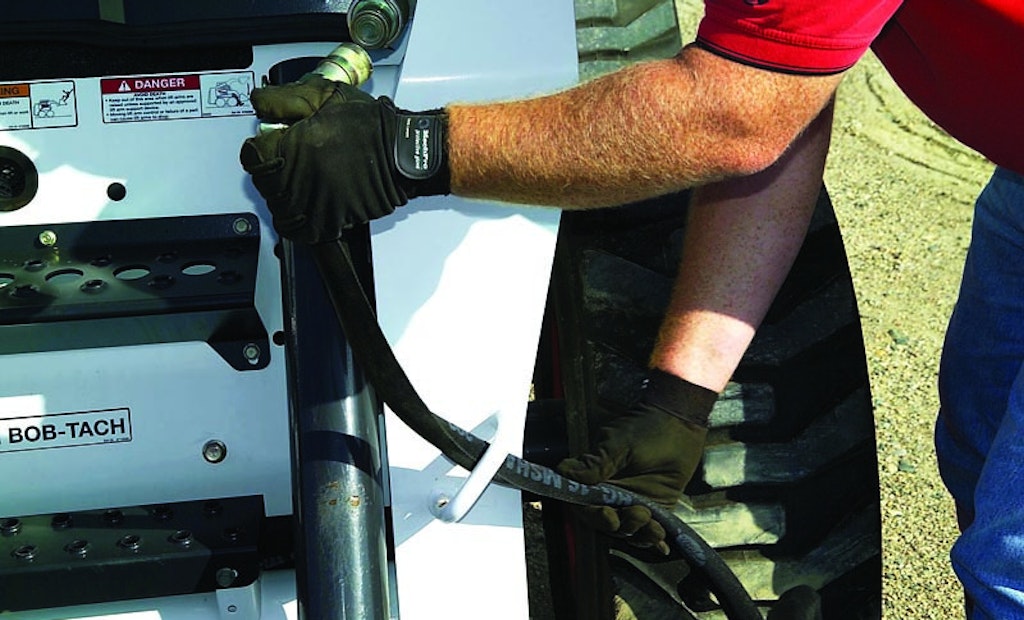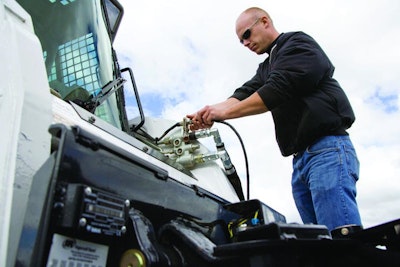
Interested in Trucks?
Get Trucks articles, news and videos right in your inbox! Sign up now.
Trucks + Get AlertsSelecting the proper hydraulic fluid for your skid-steer, track loader, mini-excavator or other compact equipment is fairly easy – simply follow the manufacturer’s recommendations.
You’ll find the recommendations in your equipment owner’s manual. John Deere, for example, fills its 36G mini-excavator with Super EX 46HN extended life zinc-free hydraulic oil and warns against mixing brands.
“Oil manufacturers engineer their oils to meet certain specifications and requirements,” the John Deere manual says. “Mixing different oils can degrade lubricant and machine performance.”
VISCOSITY AND TEMPERATURE GUIDELINES
That doesn’t mean you can’t use an oil equivalent to the manufacturer’s brand in your machine. But keep in mind that while different brands of oil are similar they might not contain the precise additives required for optimum performance.
John Deere also includes a chart listing recommended oil viscosities based on air temperature. A premium anti-wear (AW) 46 oil, for example, has a temperature range of 14 to 104 degrees F, while Deere’s Super EX 46HN has a temperature range of -4 to 104 degrees F. For low-temperature operation, Deere recommends its zinc-free Daphne Super Hydra A 32 (-22 to 86 degrees F) or an equivalent premium AW 32 oil.
Viscosity and temperature range are important factors to consider when choosing hydraulic fluid. Overheated oil forms varnish, causing valves and other components to stick, resulting in poor equipment performance.
When it comes to biodegradable oils, John Deere advises using only Exxon Mobil EAL Envirosyn 46H synthetic ester oil and suggests contacting your John Deere dealer for routine oil analysis to meet warranty requirements. The company advises draining and refilling hydraulic tank oil in the mini-excavator every 2,000 hours. And be sure to dispose of all used oil and filters properly.
Bobcat recommends using its self-branded all-season hydraulic/hydrostatic fluid. The oil is designed to provide optimum flow at subzero temperatures, while maintaining stability during periods of high-temperature use. The company says its oil cannot be duplicated by off-the-shelf fluids. Bobcat also offers a synthetic hydraulic/hydrostatic fluid for improved cycle times, increased work output and smoother operation, as well as an environmentally friendly, biodegradable hydraulic oil with anti-wear and corrosion protection additives for equipment manufactured after 2004.
KEEP IT CLEAN
So what exactly is hydraulic fluid?
Its main purpose is to transfer power across distance. The other job of hydraulic fluid is to protect against wear, rust and corrosion, as well as cool and clean internal components.
Most hydraulic fluids are formulated from hydrocarbon base oil or molecularly reformulated synthetics. Some environmentally friendly biodegradable hydraulic fluids can be vegetable-based, while fire-resistant hydraulic fluids may even be water-based.
Because of small tolerances in equipment components it’s important to keep hydraulic fluid clean.
“Dirt is the real enemy. Microscopic dirt will wear it out too,” says Bruce Coleman, co-owner of Coleman Equipment, dealer for Case and Kubota equipment, with locations in Kansas and Missouri. “Keep the system as clean as possible, particularly if you’re using hydraulic couplers. At least wipe the darn things off before you connect anything so you don’t ingest a certain amount of dirt into your system.”
Chris Barker, tech services manager at Royal Purple, maker of synthetic, commercial-grade lubricants, says it’s always best to follow OEM recommendations when selecting hydraulic fluid.
“First and foremost make sure if you’re replacing a fluid that you’re using the same type,” he says. “Next you need to look at the viscosity grades that are recommended.”
MAKING THE GRADE
Most industrial fluids use the ISO viscosity grade scale rather than the more commonly understood SAE grades – 20, 30, 40, 5W-30, 10W-40.
“In the past, most hydraulic fluids were SAE 20, but they had a very broad range of viscosity possibilities,” Barker says. “The ISO viscosity grades narrowed that down. The most common hydraulic oil viscosity grade in the ISO category is 32, 46 and 68. And all of those fit within the SAE 20 range.”
One way to ensure the hydraulic oil you’re using is working properly is to have an oil analysis performed.
“An appropriate oil analysis program will show you wear metals that are being generated, contaminants that are getting in the oil, as well as changes that are happening to the oil,” he says. “For that to be meaningful it needs to be a trend so you can see what is happening over time. One oil analysis from a particular change isn’t telling you a whole lot.”
An oil analysis can cost from $15 to $20 per sample at a consumer lab or $25 to $30 at a commercial lab. While both might do an adequate job, Barker recommends using a commercial lab because of the accuracy and detailed information provided.
STORING FLUIDS
When storing unused hydraulic fluid, make certain the package is intact and the closure or lid is secure, Barker says.
“Keep the temperature relatively consistent. Don’t store it in direct sunlight and don’t let it get rained on,’’ he says. “Best case scenario is to keep it in a climate-controlled environment. Big temperature swings can cause the packaging to breathe, pushing hot air out and cool air in.”
Ambient air contains numerous contaminants; the most common is humidity.
“Dry oil is the best oil,” Barker says. “When you introduce water into oil and introduce that into equipment, you raise the risk of corrosion and degradation.”
Remember, the life of your machine is in the oil. Be sure to change it.






